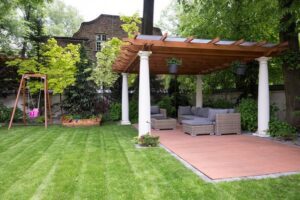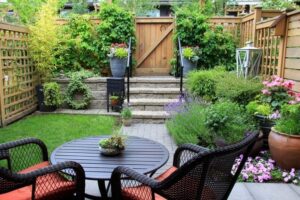Pergola Staining
Staining a pergola involves applying a pigmented solution to the wood in order to enhance its natural color and protect it from weathering and UV damage.
Summer is just around the corner, and it’s high time to prepare your outdoor space for those glorious, sun-soaked days. Elevating your backyard retreat can be effortlessly achieved by incorporating pergola staining. If you already have one, why not elevate it even further with a fresh coat of stain? This not only safeguards the wood from the harsh outdoor elements but also imparts a rejuvenated appearance to your pergola that will beckon you to bask beneath its shade all day long. In this article, we will provide you with a comprehensive guide on the art of staining your pergola. We’ll delve into the top-performing products and share expert insights on application techniques. So, pick up your brush, and let’s embark on this transformation together!
The Beauty of Pergola Staining: Shaded Garden Structures
A pergola is an architectural garden feature that creates a shaded pathway, passageway, or archway using vertical posts or pillars to support cross beams and an enduring lattice structure. It is often designed for the cultivation of woody vines. The term “pergola” finds its roots in Late Latin, specifically “pergula,” which alluded to a projecting eave. This elegant structure, resembling a gazebo, can function as an extension of a building or offer protection to an open terrace or patio.
Typically, pergolas are constructed from cedar due to its natural resistance to rot. However, alternatives such as redwood, teak, and Douglas fir are also used. For those seeking longevity and reduced maintenance, materials like aluminum or vinyl are excellent choices as they are impervious to cracking, warping, or rotting over time.
Enhance Your Pergola Staining: Beauty, Protection, and Longevity
Pergolas not only offer shelter from the sun and rain but also serve as a captivating enhancement to your outdoor space. Enhancing your pergola with a fresh coat of stain can significantly improve its aesthetics while bolstering its longevity.
 There are several compelling reasons to consider staining your pergola. Firstly, it acts as a shield against the elements, safeguarding your pergola from weather-related wear and tear. Secondly, staining imparts a richer and more refined color to your pergola, elevating its overall appearance. Lastly, staining plays a pivotal role in prolonging the life of your pergola by thwarting rot and other potential damage.
There are several compelling reasons to consider staining your pergola. Firstly, it acts as a shield against the elements, safeguarding your pergola from weather-related wear and tear. Secondly, staining imparts a richer and more refined color to your pergola, elevating its overall appearance. Lastly, staining plays a pivotal role in prolonging the life of your pergola by thwarting rot and other potential damage.
If you’re contemplating staining your pergola, make sure to opt for a high-quality stain specifically designed for outdoor use. The application process is relatively straightforward, but it’s vital to adhere closely to the manufacturer’s guidelines. With a bit of dedication, you can enjoy a striking and durable pergola that adds value to your home.
Enhancing Your Pergola Staining for Protection and Beauty
Pergolas offer more than just protection from the elements; they also enhance the allure of your outdoor space. Giving your pergola a fresh coat of stain can not only enhance its visual appeal but also ensure its long-lasting durability.
There are several compelling reasons to consider staining your pergola. To begin with, it acts as a protective barrier, shielding your pergola from the wear and tear caused by adverse weather conditions. Additionally, pergola staining adds depth and sophistication to the color of your pergola, elevating its overall aesthetic. Lastly, staining plays a crucial role in extending the lifespan of your pergola by preventing rot and potential damage.
If you’re considering staining your pergola, it’s essential to choose a high-quality stain specifically formulated for outdoor use. The application process is relatively straightforward, but it’s crucial to follow the manufacturer’s instructions closely. With a little effort, you can enjoy a stunning and long-lasting pergola that adds value to your home.
Choosing the Right Stain for Your Pergola
When you’re in the process of selecting the ideal stain for your pergola staining, there are several crucial considerations to take into account. First and foremost is the material from which your pergola is constructed. If your pergola is crafted from cedar or redwood, the recommended choice is an oil-based stain. Conversely, if your pergola is  constructed from pressure-treated lumber, a water-based stain is the more suitable option.
constructed from pressure-treated lumber, a water-based stain is the more suitable option.
The second important factor to weigh is your desired pergola color. There is a wide array of stain options available in both oil-based and water-based formulations. Some stains are notably lighter, merely imparting a subtle darkening effect to the wood, while others are considerably darker, rendering the wood nearly black in appearance.
The third vital consideration revolves around the level of sunlight exposure your pergola will experience. If your pergola resides in a shaded area, opting for a lighter stain is advisable, as it will help prevent excessive heat absorption and maintain a cooler surface. Conversely, for pergolas situated in sunnier locations, a darker stain is recommended to reduce the risk of fading caused by the sun’s powerful UV rays.
Pergola Staining Guide
- To preserve the aesthetics and safeguard your pergola from weathering, it’s essential to periodically apply a stain.
- Ensure your chosen stain is explicitly formulated for outdoor applications and harmonizes with your pergola’s color.
- Before commencing the staining process, make certain to thoroughly cleanse the pergola by employing a pressure washer or garden hose to eliminate dirt and debris.
- Apply the stain consistently using either a brush or roller, taking care to prevent any undesirable drips or accumulation of stain on the ground beneath the pergola.
- Allow the stain to thoroughly dry before reintroducing any furniture or decorations to your pergola.
Enhance Your Beauty and Longevity with Proper Pergola Staining
Staining your pergola plays a vital role in preserving its aesthetics and ensuring its durability. By following a straightforward process with minimal exertion, you can achieve a stunning, long-lasting finish. Whether you aim to shield your pergola from the elements or infuse some vibrant hues into your outdoor area, staining is the ideal approach. Take out your supplies and demonstrate the effort you’ve invested when showcasing your newly-pergola staining to others!
